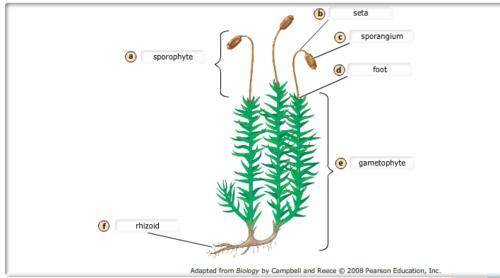Nonvascular Plants
Nonvascular plants (informally called bryophytes) generally live very close...

Biology, 30.03.2020 16:40 blanca04fp
Nonvascular Plants
Nonvascular plants (informally called bryophytes) generally live very close to the ground, sprawling out rather than growing upward. This growth form is due to their thin body parts and lack of vascular structures that would support upward growth. Three phyla of bryophytes exist today: liverworts, hornworts, and mosses.
Part A - Bryophyte structure
Label the structures on this diagram of a moss.
Drag the labels onto the diagram below. Not all labels will be used.
In the life cycle of bryophytes, gametophytes are the dominant stage and are generally larger than sporophytes. The sporophytes of mosses are made up of a foot, a seta, and a sporangium. The foot is embedded in the gametophyte and absorbs nutrients from it. The seta, or stalk, transports the nutrients to the sporangium, which produces spores.
Rhizoids, which resemble the roots of vascular plants, anchor the gametophytes to a substrate. Rhizoids are not vascular structures.

Answers: 2
Another question on Biology


Biology, 22.06.2019 00:00
Which ideas did your answer contain? check all that apply. no food for organisms no oxygen in the atmosphere no trees or flowering plants no products based on trees or plants (building materials, medicines, fuels, fibers) no fossil fuels
Answers: 3

Biology, 22.06.2019 01:30
Which is an advantage of having memory cells when a pathogen is encountered for a second time. a) the memory cells are what proliferate into clones of cells in response to the binding of an antigen. b) memory cells are vital to the primary immune response in that they immediately recognize pathogens even at the first encounter. c) memory cells are essentially effector cells that are short lived and attack antigens even without having a receptor specific to that antigen. d) it ensures that more lymphocytes with a receptor specific to a particular antigen will be present than in a host that had never encountered that pathogen.
Answers: 1

Biology, 22.06.2019 06:10
The normal shape of an enzyme is as shown in structure a. if the enzyme’s shape changes to that shown in structure b, what are two consequences of this change?
Answers: 1
You know the right answer?
Questions

Health, 11.03.2021 18:30

Mathematics, 11.03.2021 18:30

Mathematics, 11.03.2021 18:30

Biology, 11.03.2021 18:30

Biology, 11.03.2021 18:30





Mathematics, 11.03.2021 18:30


Physics, 11.03.2021 18:30

Social Studies, 11.03.2021 18:30



Mathematics, 11.03.2021 18:30


Biology, 11.03.2021 18:30

Mathematics, 11.03.2021 18:30




